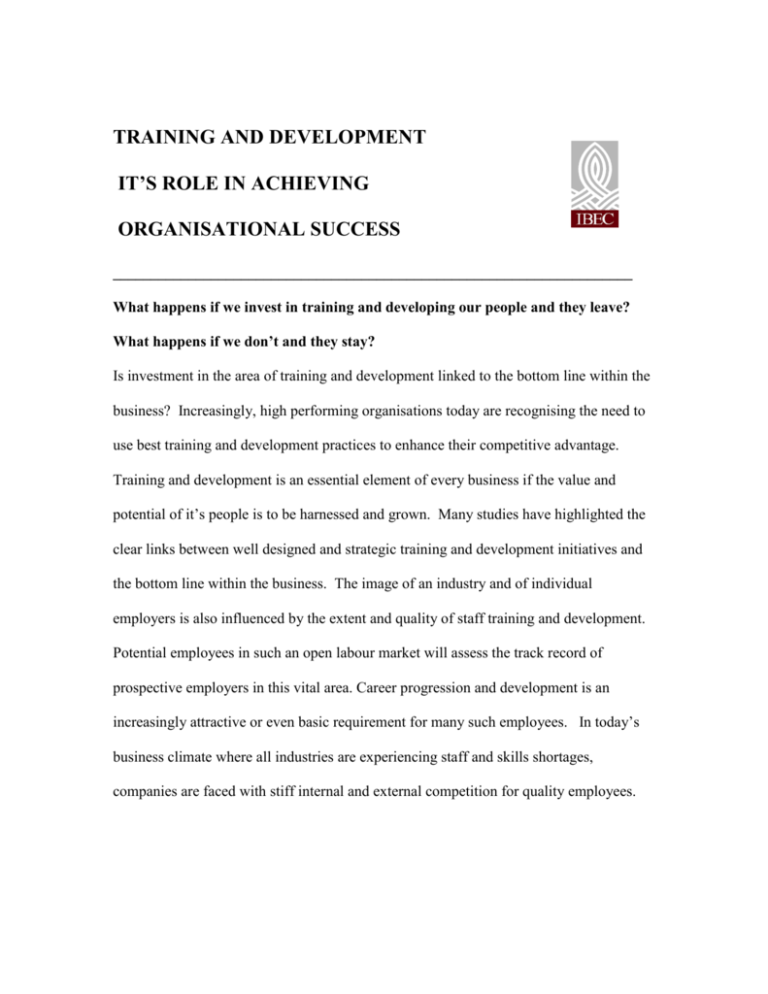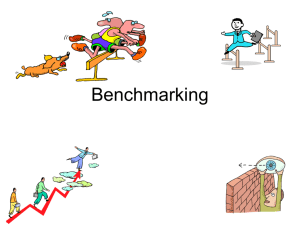training and development - it's role in achieving
advertisement

TRAINING AND DEVELOPMENT IT’S ROLE IN ACHIEVING ORGANISATIONAL SUCCESS _____________________________________________________________________ What happens if we invest in training and developing our people and they leave? What happens if we don’t and they stay? Is investment in the area of training and development linked to the bottom line within the business? Increasingly, high performing organisations today are recognising the need to use best training and development practices to enhance their competitive advantage. Training and development is an essential element of every business if the value and potential of it’s people is to be harnessed and grown. Many studies have highlighted the clear links between well designed and strategic training and development initiatives and the bottom line within the business. The image of an industry and of individual employers is also influenced by the extent and quality of staff training and development. Potential employees in such an open labour market will assess the track record of prospective employers in this vital area. Career progression and development is an increasingly attractive or even basic requirement for many such employees. In today’s business climate where all industries are experiencing staff and skills shortages, companies are faced with stiff internal and external competition for quality employees. Each employer who invests seriously in the area of Training and Development will reap the benefits of an enriched working environment with higher levels of staff retention as well as increased productivity and performance. In a recent IBEC survey (HR Benchmarking Report 2004), respondents were asked to identify the key drivers of training initiatives over the past year and for the 12 month period ahead. The top three were health and safety, technical changes and customer service. In other words, organisations are now using training and development as an incentive to retain and motivate their people and to be recognised as an employer of choice as well as giving staff the skills and knowledge needed to keep up with technological change and customer service. A further key finding in this survey was that the vast majority of companies surveyed (9 out of 10) stated they provided support to employees to pursue outside educational programmes. This support consisted of both financial aid as well as time off for both study and exam leave. Both of these initiatives may have benefits which are difficult to quantify, but areas such as staff turnover and morale are clear indicators of success in this field. While research indicates an increased interest in and awareness of the benefits of training, the question needs to be asked as to whether this translated into Irish organisations establishing training policies and / or increasing their spend on training? A National Survey of Training and Development in Ireland conducted by Garavan and Heraty in 2003 outlined a number of key trends which are emerging in the Training arena in Ireland. Some of the key ones include the following : Irish organisations spend on average 3.55% of payroll on training which does not compare favourably with other EU member states. (The IBEC HR Benchmarking Survey indicates a figure of 3.15%). The average number of days training provided per employee per year in 2004 was 5.35. (IBEC HR Benchmarking Survey indicates an average figure of 3-5 days). There is evidence of a positive attitude to training and development among those surveyed with many viewing it to be an important component in the organisation’s strategy. Smaller firms are more likely to deliver training in an ad hoc way with larger companies applying a more formal approach to managing training. Line managers and employees seem to have a greater role in the organisation and design of training and development. There is still a strong usage of the traditional forms of learning strategies including classroom teaching and subject driven courses, although there is a growth in the use of new technology to deliver training. Learning in teams is an increasingly popular form of learning in the workplace. Employees are now taking more personal ownership for their own development. However, the percentage spend and number of days spent training staff may be useful in order to get an overview of the companies commitment to training and development, but it is the manner, approach and content of the training initiatives as well as their assessment and follow up which determine success. It is all too easy to throw money at a performance problem and assume that a training course will sort it out, when this may well be just putting a plaster over an open wound. Training initiatives need to be strategically aligned to the overall company mission and goals. They need to be designed and delivered with the aim of helping staff to achieve their departmental as well as personal goals, so the trend of increased involvement by line managers and employees is a positive development in terms of ownership of the training and learning. By adopting a strategic approach to training and development rather than an unplanned and ad hoc one, training and development initiatives become more targeted, measurable and effective. However, increased flexibility in terms of training delivery may need to be expanded in the future to facilitate participant’s different learning styles as well as lifestyles. They also need to be assessed in terms of reaction, learning, behaviour change and results to determine the added value to the organisation. This area of evaluation is one whereby many organisations simply evaluate the effectiveness of the training intervention based on the initial reaction of participants, an area which clearly needs to be expanded. A sample training and development approach is outlined below describing the essential elements in a strategic approach. Establishment of Company Training and Development Policy Sample Training and Development Plan Mission statement / Aims / Objectives / Ethos *** Identification of Training and Development Needs Assessment of organisational needs / Employee needs / Job analysis Define objectives - Individual needs / Organisational needs / Long-term / Short-term *** Development of Training and Development Plan Types of training and development required - Knowledge / Skills / Attitudinal / Personal Development / Continuing Professional Development (CPD) Establishment of standards/ Gap in current knowledge, skills, attitude levels *** Selection of Training Methods Formal / Informal On-the-job methods - “Sitting by Nelly, Coaching, Mentoring, In-house courses Off-the-job methods - Work placement, External courses, Distance learning, Workshops Design of in-house programmes / Participation in externally run programmes *** Implementing Training and Development Selection of participants Staff scheduling Recording of training undertaken Conducting and / or facilitating training and development *** Evaluating Training and Development Process Measurement of results against standards Reaction / Learning / Behaviour / Results Feedback and redesign if necessary of company policy and objectives In order to remain competitive and to ensure excellent staff are attracted to and remain within the organisation, companies need to ensure that the training and development of all employees is an issue which is taken seriously. By investing in the development of the people who are the face of the business, companies can get ahead of the competition and excel in what they do. One of the most important aspects of managing people lies in helping employees become more effective at their jobs and being able to adapt to that job or another job as he/she matures within the organisation. This requires a high level of coordination between employee training and development and the range of other personnel functions, such as recruitment and selection, performance appraisal, reward systems and employee relations. Identification of a company’s training needs, designing a relevant training plan, selecting and implementing the resulting training programme and evaluating it’s success are therefore integral elements of the overall Human Resource process. However, for any of these functions to be effective, the Training plans and policies must be in line with the organisation’s strategic objectives. The Training function is increasingly considered to be a key player in helping the organisation to achieve it’s goals through it’s people as it is becoming more generally accepted that there is a strong correlation between organisational success and investment in training and development. There is now a growing awareness of the importance of a planned approach to training and development as a tool for competitive advantage, staff recruitment, selection, retention and motivation. The whole Training and Development function has increasingly acquired status as the instrument for breaking new ground and bringing about change through its developmental activities. Training managers must provide expert advice to top level management, usually about the value to the organisation of a particular kind of training. Furthermore, they must have the means to persuade management as to a systematic approach to training outlining for example, the extent to which changes in structure and procedures will be necessary to support training. The training must take place within a framework of partnership between the trainer, employer and employee. This relationship must be characterised by trust between all stakeholders so that training does not simply reflect the views of the employer. This commonality of interest must be identified and worked towards. Training and development is about making a difference to the bottom line, both in terms of how people feel about their jobs as well as in the area of performance and productivity. Ultimately, it is about adding real value to the organisation and those who comprise it.








